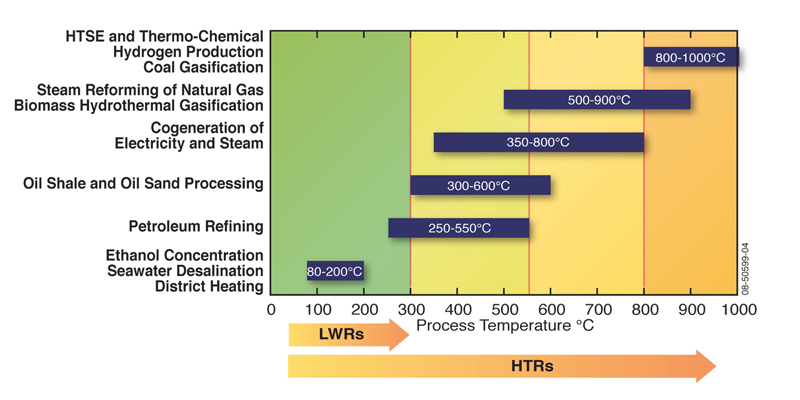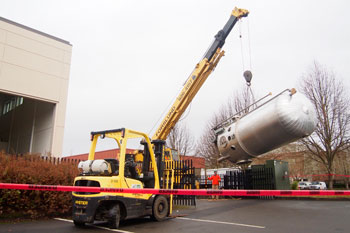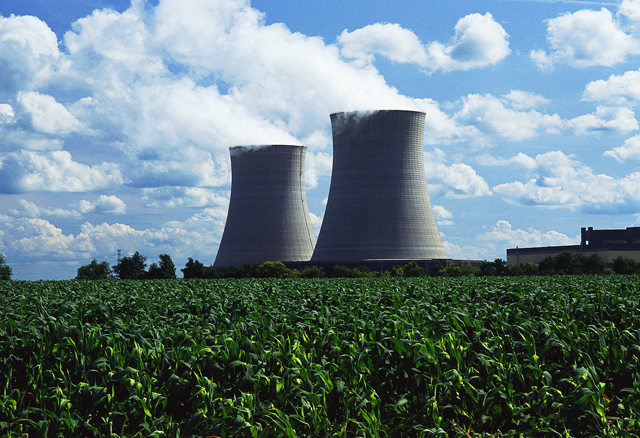A Safer, Greener Nuclear Power
A nuclear power technology that can be deployed for everything from seawater desalination to production of hydrogen vehicle fuel is the type of technology that can shift an energy economy. A new $4.9 million test facility at Oregon State University (OSU) Department of Nuclear Engineering and Radiation Health Physics is part of a national effort to develop very-high temperature gas reactor technology, which could drastically change energy production in the United States.
The High Temperature Test Facility (HTTF) at Oregon State isn’t an actual nuclear reactor, and it doesn’t contain any nuclear fuel. But, it is designed to mimic the real thing. The fully functional 1:64 scale model allows researchers to safely test the design’s safety aspects, which is an important component of the licensure process necessary to bring this technology to the table by 2030. It’s a revolutionary technology with roots in the very beginnings of nuclear power.
Project Beginnings
Standing on the shoulders of decades-long technological advancements, HTTF is part of the fourth generation of nuclear reactors. In the early 2000s, 12 nuclear nations – Argentina, Brazil, Canada, China, France, Japan, Republic of Korea, Russian Federation, Republic of South Africa, Switzerland, United Kingdom, United States – and Euratom (European Atomic Energy Community, which has 28 European Union members) began to cooperate on a plan for future nuclear power technologies. Forming the Generation IV International Forum, they created the Generation IV Technological Roadmap as a guide to develop six technologies they deemed to be the future of nuclear power.

Photo Courtesy: OSU | Brian Woods, PhD, and OSU nuclear engineering graduate students J.J. Utberg and Matthew Hertel examine an HTTF electric panel.
The earliest ancestor of nuclear reactors came from discoveries made through WWII’s Manhattan Project. From this knowledge base came the first generation of prototype power reactors in the 1950s and 60s. Generation II reactors were built from these prototypes and deployed by US utility companies from the 1970s to mid-1990s. Some big leaps in the technology occurred in the mid-90s with the creation of Gen III modular reactors, which were smaller than Gen II reactors in terms of power output yet more advanced in safety and efficiency. New reactors deployed in the near future will most likely be from these Gen III designs.
The authors of the Gen IV Roadmap realized that for nuclear power to be competitive beyond 2030, and be a viable solution to future energy needs, several issues needed to be addressed. Sustainability, economics, safety, reliability and proliferation resistance were made priorities for Gen IV designs. Six technologies were determined to be solutions to these challenges: gas-cooled fast reactor, lead-cooled fast reactor, molten salt reactor, supercritical-water-cooled reactor and very-high-temperature reactor systems.
Each nation selected technologies of most interest to them and began working on the necessary research and development to bring them to market by 2030. The United States operated two Gen II gas reactor designs in the past and took a particular interest in the modular design of the technology, which HTTF models. Peach Bottom, a prototype helium reactor, was in operation from 1967-1974. Fort Sr. Vrain, a helium-cooled power reactor operating from 1979-1989, generated about five billion kilowatts of electricity, according to General Atomics data. Although both are decommissioned now, much was learned from the operation of these and other gas-cooled reactors worldwide.
Since their decommissioning, an entire generation of reactor development has taken place. The advent of modular reactors offered new possibility for the gas reactor technology to be fashioned into the modular very-high temperature gas reactor design. Various national labs, universities and private companies began conducting the research and development necessary to bring the technology to market. HTTF at Oregon State is an important piece of the larger research effort.
Understanding the Technology
HTTF models a modular design, meaning it has smaller megawatt output than the larger Gen II reactor designs. Modular reactors generally fall into the 200 megawatt range, whereas the larger Gen II reactors could have an output of 1,000 megawatts or more. The major difference between gas reactors and traditional reactors is the coolant. Most nuclear reactors are cooled by water. In a power reactor the controlled nuclear reaction generates heat, which is eventually used to boil water. The steam generated through the boiling process is then used to turn a set of turbines attached to electric generators, which powers the electricity grid. After going through electric turbines, steam is condensed back into water and then pumped to the nuclear reactor where it starts the whole cycle over again.
Based on this design, conventional wisdom would suggest that people don’t want nuclear reactors running at much higher temperatures than what it takes to boil water – any higher and the word “meltdown” comes to mind. However, the helium coolant allows these gas reactors to safely operate at a much higher temperature. In a water-cooled reactor you are limited by the thermal capabilities of water, which can only get it so hot before it boils. Water boils at approximately 212˚F, but by pressurizing the water, system temperatures of 500-600˚F can be reached. Helium is much more flexible in terms of temperature so the gas reactor system can be safely heated to a 3000˚F operating temperature. This has the advantage of making the reactor operate more efficiently and improving safety characteristics of the design. In fact, General Atomics found that these designs increased thermal efficiencies by 50 percent when compared to conventional water-cooled reactors.
Current high temperature gas reactor designs can be divided into two major types: prismatic block and pebble bed designs. HTTF models a prismatic block design with a core consisting of hexagonal blocks of graphite forming a honeycomb-like core structure containing small cylinders of nuclear fuel. Holes are fabricated in these hexagonal blocks, which allow for the flow of helium and removal of heat generated through the nuclear reaction. It is powerful technology with many potential benefits and substantial engineering challenges.

Image Courtesy: Next Generation Nuclear Plant Alliance | This graph shows the related temperatures for process heat uses. “LWRs” refer to light water reactors, and “HTRs” refer to high temperature gas reactors.
Benefits and Challenges
The ability to achieve 3000˚F operating temperatures is the main attraction of gas reactors and is a major factor in the Gen IV selection criteria. Currently, nuclear reactors are used exclusively for electricity production. But high operating temperatures create so much surplus heat they open the door for nuclear reactors to branch out to other demand sectors, which are currently dominated by fossil fuels.
In terms of energy industry applications, the technology could help bridge the gap between current and future transportation fuels. The Next Generation Nuclear Plant Alliance (NGNP) sees potential for gas reactors to extend the life of domestic oil and natural gas supplies until other fuels become technically or economically viable. Surplus heat generated by gas reactors could play a role in a demand sector called “process heat” or heat necessary for industry production processes. Gas reactors could be used to generate process heat for seawater desalination, petroleum refining, co-generation of electricity and steam, steam reforming of natural gas and hydrogen production. It is this ability to branch out to other demand sectors that makes gas reactor technology one of the most versatile innovations in the industry.
From an economical perspective, the idea of hydrogen production is a key component. According to the NGNP Alliance, if the United States were able to produce hydrogen transportation fuel at a price competitive with gasoline, it could shift its energy economy and lessen its dependence on foreign oil. In addition to this, a burgeoning nuclear power industry would create jobs. The technology also responds to decades-old criticism of nuclear power – the high cost of construction and operation that accompanies building a Gen II design power plant – which can cost in excess of $6 billion and take years to complete.
By design, modular reactors are smaller and easier to fabricate. And, while no one can accurately forecast the cost of building future Gen IV reactors, one can say that modular reactors require a significantly smaller investment. Part of this is due to the opportunity for more local construction and assembly. Currently, only a few companies in the world can forge large vessels and other reactor components needed for 1,000 megawatt plus reactors. The considerable reduction in the plant size with the modular design makes construction and operation a more feasible investment.
When examining the technology from a sustainability and efficiency standpoint, several factors come into consideration. High temperatures allow for more fuel burn-up during the fuel cycle, thus resulting in less waste and a more efficient use of the fuel. Because gas reactors run so hot, fuel had to be specially fabricated for use in these designs. The spherical fuel looks like a candy jaw-breaker with a uranium center. It’s called “tristructural-isotropic fuel” or TRISO fuel. The uranium fuel is encased in spherical layers of carbon and silicon carbide. Like other nuclear fuel, it can be reprocessed for multiple rotations through a reactor.
Although TRISO can be reprocessed like other nuclear fuels, the impetus to do so isn’t there. In the current energy economy, it’s cheaper to mine new fuel than it is to reprocess, meaning the once-through fuel cycle is the prevailing choice by most operators. Another factor limiting reprocessing is an influx of uranium on the market due to the Megatons to Megawatts program, which blends uranium from dismantled nuclear weapons into nuclear reactor fuel. This equates to a significant amount of relatively cheap fuel on the market for some time. According to the program’s website, they have converted 472.5 metric tons of bomb-grade, highly enriched uranium (HEU) into 13,603 metric tons of low enrichment uranium (LEU) – the equivalent of 18,899 nuclear warheads.
Another concern regarding fuel is proliferation resistance. Researchers at Idaho National Laboratory say that while TRISO fuel is more proliferation resistant than other Gen IV technologies, it’s not much different than light water reactor fuel. There are, however, additional steps to access the nuclear material. In order to access the uranium kernels, the fuel must first be crushed and then introduced to chemical separation processes to extract the nuclear material. The extra coating on the fuel offers additional safety benefits as well.
According to NGNP, the extra coating on the fuel and the fact that it is encased in a graphite core help reduce the risk of not only heat damage to the fuel but also the likelihood of a radiological release. By coating the fuel with ceramic, it provides an initial layer of containment. The graphite core, reactor vessel and containment building provide additional layers of protection.
Of course, coupled with technological benefits are some challenges that must be overcome before designs can be put on the market. Other universities and labs have researched fuels, materials and the modeling code, but the final component of the Gen IV requirements is safety and reliability. That’s where HTTF comes in.
Validation of a Design
Potentially, the worst accident that could occur with a gas reactor is a catastrophic failure of pipes connected to the reactor vessel, which would depressurize the helium-filled environment and allow oxygen into the system. The oxygen could rapidly oxidize and burn graphite blocks that make up the honeycomb reactor core, thereby damaging the structural integrity of the core itself. This is exactly what HTTF will simulate.

Photo Courtesy: OSU | The large reactor vessel of HTTF arrived at the OSU Radiation Center in February 2013.
Since it is modeling a high temperature gas reactor concept, HTTF is designed to operate at temps that would be seen in the actual reactor, approximately 3000˚F. This makes it a challenge to find the right materials to model the actual reactor while being able to withstand these temperatures. Built by Harris Thermal, Inc., of Newberg, Oregon, the vessels are made of stainless steel, and the heater core region is made of high temperature ceramic. It is this ceramic material that will reach the highest temperatures in the test facility. HTTF is modeling the prismatic block type gas reactor. Thus, the high temperature ceramic is fashioned into blocks that both hold heater rods and allow for helium to flow for cooling of the heater core. Standing approximately 18-feet tall and 6-feet wide, HTTF is a large facility. Its labmate, the Hydro-Mechanical Test Facility, is separated by a mere 36-inch corridor between two towering experiments.
Accident scenarios will be simulated by opening a “break” valve to simulate the failure of a pipe connecting the reactor vessel to the coolant tank. Sensors at HTTF will then track release of helium gas into the reactor confinement and the in-rush of other gases from the reactor confinement into the reactor vessel itself. In addition to tracking the movement of various gases during this accident scenario, HTTF will monitor fluctuations in temperature in prismatic blocks as decay heat is generated and removed from the reactor. This data is collected under stringent quality control requirements and can be used as a comparison against computer models of HTTF. The great advantage of using a test facility like HTTF in this role is its ability to model these accident scenarios accurately without risking release of any radioactive material, since the facility is entirely electrically heated.
The point of this testing is to verify that current computer models of the system are correct in their predictions. Researchers at other institutions have developed these predictive models but won’t know how correct or incorrect they are until a prototype is actually built and put through the paces. HTTF will not only be modeling accident scenarios but will give baseline data for normal operations in the reactor design. It’s a necessary step on the path of licensure with the US Nuclear Regulatory Commission.
As part of the licensing process for new reactor types, such as the modular high temperature gas reactors, an owner must demonstrate that the reactor can operate within very specific safety boundaries, even during an accident scenario. Experiments conducted at facilities like HTTF can help to characterize behavior of these reactors and thus determine how they operate from a safety perspective. These facilities are also used to develop and check computer codes and models that will be used in the future for analysis of advanced nuclear reactors. So, HTTF may operate for 10 years or so, but its legacy will live on long after that in computer codes and models that it helped develop and validate.
What the Future Holds
The idea of Gen IV is to put forth six licensed technologies on the market by 2030 and let future stakeholders decide how best to use them. The very-high temperature gas reactors offer a wide range of benefits with potential to drastically change energy in the United States. The potential to produce hydrogen transportation fuel for less than it costs to produce gasoline is probably the main benefit right now. The technology could also play a major role in reduction of greenhouse gases through large-scale displacement of fossil fuels in a variety of demand sectors since nuclear reactors have no carbon emissions.
Of course, all of this comes after the more immediate hurdles of testing and licensure of the design. It will be another 15 years before one could potentially see a modular very-high temperature gas reactor on the market, much less the fleet of reactors that would be needed to realize many potential benefits.
It’s a long process. After nearly six years in development and planning, the HTTF facility arrived at Oregon State in early February 2013 to be assembled. The facility was slated to begin its test runs on October 1, 2013, and researchers plan to operate the facility until the project’s funding runs out. For more information on OSU’s Nuclear Engineering and Radiation Health Physics, go to www.ne.oregonstate.edu/httf. For more info on “A Technology Roadmap for Generation IV Nuclear Energy Systems,” go to www.gen-4.org. And, for info on TRISO Fuel Research, go to: https://inlportal.inl.gov/portal/server.pt?open=514&objID=1269&mode=2&featurestory=DA_149275.





























